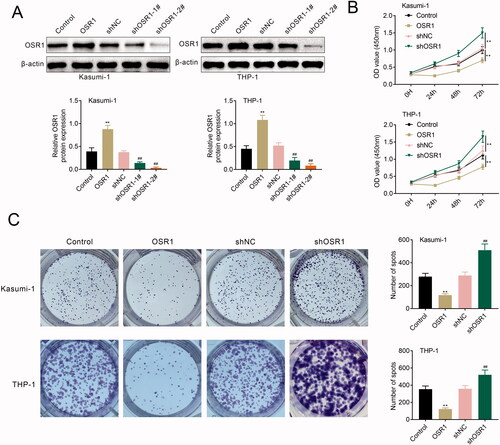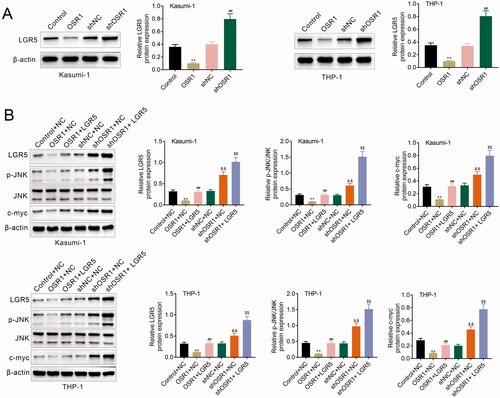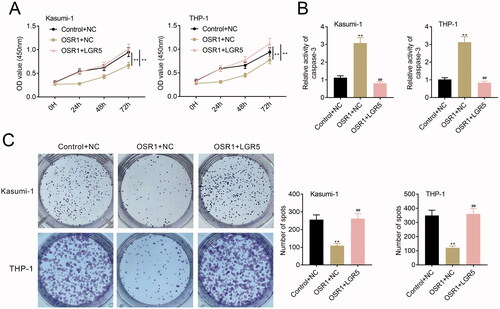Figures & data
Table 1. Primer.
Figure 1. Reduced OSR1 in acute myeloid leukaemia. (A) mRNA expression of OSR1 was reduced in the blasts isolated from the patients and acute myeloid leukaemia cells (Kasumi-1, THP-1 and AML-193) compared to the healthy volunteers. (B) Protein expression of OSR1 was reduced in the blasts isolated from the patients and acute myeloid leukaemia cells (Kasumi-1, THP-1 and AML-193) compared to the healthy volunteers. ** vs. normal blasts, p < .01.

Figure 2. Silence of OSR1 contributed to acute myeloid leukaemia cell proliferation. (A) Protein expression of OSR1 was increased in Kasumi-1 and THP-1 transfected with pcDNA-OSR1 and decreased by shRNA-OSR1. (B) Over-expression of OSR1 reduced the cell viability of Kasumi-1 and THP-1, shRNA-mediated silence of OSR1 enhanced the cell viability. (C) Over-expression of OSR1 reduced the cell proliferation of Kasumi-1 and THP-1, shRNA-mediated silence of OSR1 enhanced the cell proliferation. ** vs. control, p < .01. ## vs. shNC, p < .01.

Figure 3. Silence of OSR1 suppressed acute myeloid leukaemia cell apoptosis. (A) Over-expression of OSR1 promoted the cell apoptosis of Kasumi-1 and THP-1, shRNA-mediated silence of OSR1 suppressed the cell apoptosis. (B) Over-expression of OSR1 promoted the caspase-3 activity of Kasumi-1 and THP-1, shRNA-mediated silence of OSR1 suppressed the caspase-3 activity. (C) Over-expression of OSR1 reduced protein expression of Bcl-2, while enhanced Bax and cleaved PARP, in Kasumi-1 and THP-1, shRNA-mediated silence of OSR1 enhanced Bcl-2, while reduced Bax and cleaved PARP. ** vs. control, p < .01. ## vs. shNC, p < .01.

Figure 4. OSR1 suppressed LGR5-mediated activation of JNK pathway. (A) Over-expression of OSR1 reduced protein expression of LGR5 in Kasumi-1 and THP-1, shRNA-mediated silence of OSR1 enhanced LGR5 expression. (B) Over-expression of LGR5 attenuated OSR1 over-expression-induced decease of LGR5, JNK phosphorylation and c-myc, while aggravated OSR1 silence-induced increase of LGR5, JNK phosphorylation and c-myc. ** vs. control + NC, p < .01. ## vs. shNC or OSR1 + NC, p < .01. && vs. shNC + NC, p < .01. $$ vs. shOSR1 + NC, p < .01.

Figure 5. OSR1 contributed to suppression of acute myeloid leukaemia cell proliferation by inhibiting LGR5. (A) Over-expression of OSR1-induced decrease of cell viability in Kasumi-1 and THP-1 was reversed by over-expression of LGR5. (B) LGR5 over-expression weakened over-expression of OSR1-induced increase of caspase-3 activity in Kasumi-1 and THP-1. (C) LGR5 over-expression counteracted the suppressive effect of OSR1 over-expression on cell proliferation of Kasumi-1 and THP-1. ** vs. control + NC, p < .01. ## vs. OSR1 + NC, p < .01.

